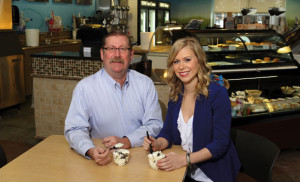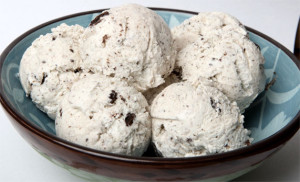Oreo run spawns creation of Cookies and Cream ice cream treat at SDSU
There were no Oreo cookies to be had at the nearby grocery store on this particular day in September of 1979.

Joe Leedom and daughter, Allison, a junior SDSU nursing student, enjoy some cookies and cream ice cream at the SDSU Dairy Bar. Back in 1979, Leedom, a dairy science major and a dairy plant student supervisor, was involved in the creation of the ice cream treat. Today, it is one of the most popular flavors among the 50 offered at the dairy bar.
That’s because dairy science students, Joe Leedom and Joe Van Treeck, still outfitted in their whites from working in the SDSU Dairy Plant, made a fast trek to the store and purchased all the Oreos on the shelf.
Their hurried excursion resulted in the creation of Oreo ice cream. Later, with the name changed to cookies and cream due to trademark rules, the ice cream is one of the most popular flavors among the 50 offered at the SDSU Dairy Bar, or for that matter, one of the top brands found anywhere.
In 2012, the dairy plant produced 4,750 gallons of cookies and cream ice cream, which accounted for about 13 percent of the 37,000 gallons of total ice cream production for the year. Cookies and cream consistently ranks second only to vanilla in annual popularity, according to dairy plant data.
Ice cream experiment
Leedom, a 1981 graduate, is currently the plant superintendent for Dean Foods in Sioux Falls, a national leader in the production of dairy products under the Land O’ Lakes and Country Fresh brand names.
Van Treeck ’80 is the chief executive officer of Alaska Glacier Products in Anchorage. The company is the No. 1 bottler of Alaska Glacier sourced water.
Although it was more than three decades ago, Leedom still recalls sitting in the dairy plant office with Van Treeck and professor Shirley Seas, manager of the dairy plant, exploring the world of ice cream.
“Shirley gave us a lot of flexibility to experiment with different ice cream flavors,†says Leedom, a dairy plant student supervisor at the time. “He looked at us and said, ‘Why don’t you guys go out to the grocery story and bring back some Oreo cookies.’ Well, we looked at him and said something like, ‘Yeah, right.’â€
Seas was a long time faculty member who passed away in 1988. He earned his bachelor’s and master’s degrees in dairy manufacturing at SDSU in 1955 and 1959, respectively. He is credited with building the dairy manufacturing program at State. He coached the dairy products judging team to five national titles.
Refining the process
Leedom and Van Treeck took their marching orders, returning to the plant with sacks full of Oreo cookies. Before history could be made, though, several tweaks in the process took place before the sweet concoction was dubbed a success.

In 2012, the dairy plant produced 4,750 gallons of cookies and cream ice cream, which accounted for about 13 percent of the 37,000 gallons of total ice cream production for the year.
“We had a single barrel ice cream freezer and a batch freezer back then,†relates Leedom. “We had a fruit feeder, where the cookies were crushed and fed into the ice cream. The chunks were a little too big at first so we kept adjusting the settings to get smaller bits of cookie.
“Eventually, we were able to narrow it down and got what we thought was a good distribution.â€
The finished product was put in three-gallon tubs and serving commenced at the dairy bar, much to the satisfaction of the customers, according to Leedom, who was confident of their approval.
“It took off right away,†he says. “When we did a little taste testing when the ice cream was coming out of the batch freezer, we knew that we had something.â€
Leedom remembers that when Seas sent them on the cookie run, the professor was likely fulfilling something that had been on his mind for a few years.
“I knew that Shirley had this idea about it, because he had seen it many years before we actually did it,†he says. “From what I remember, he was kind of systematic about how to do things. He sees it, starts to think about how we would do it and I think he was waiting for the right situation, the right time.â€
From memory to creation
In a letter drafted by Seas, he reports his experience when taking a dairy judging team to Atlantic City, N.J.
“We stopped at a little restaurant for a meal and in this restaurant they had a small counter freezer,†he writes. “They were putting Oreo cookie crumbles on top of the freshly frozen ice cream. The combination was delicious.
“I started to wonder if broken up Oreo cookies would work in vanilla ice cream. So after returning to school, we purchased packages of Oreo cookies and put them in the ice cream.
“We never heard so many compliments on a product. The fame of Oreo-flavored ice cream spread like a fire going through a dry grass field.â€
Says Leedom, “It was one of the products we could hardly keep stocked in the dairy bar. We had to figure out how to get the cookies.â€
That question was answered by Seas, who ended up contacting SDSU Food Service and began purchasing Oreo cookies in bulk. With everything in place, Seas went into promotion mode, says Leedom.
“Shirley was quite an interesting individual,†he says. “His office was right off the side of the dairy bar. He’d come out when people were at the counter and with a big smile he’d say,
‘Try that one, it’s very tasty, you know there’s more where that came from.’â€
Leads to long career
Humble about his involvement, Leedom stresses that Van Treeck, Seas and himself weren’t looking for any fame or fortune, but rather simply trying something new, which they were always encouraged to do at the dairy plant.
Leedom originally came to SDSU in 1977 intending to pursue a pre-vet degree. But after taking a dairy science class he found his calling. The teacher happened to be Seas
and Leedom soon switched his major to dairy science.
“I decided that dairy science looked better to me,†he says. “It fit my interests with more opportunities.â€
It was the beginning of a long career in dairy manufacturing. Three years after graduating, he climbed to his first plant manager position at age 25. During the years, he moved to larger dairy plants throughout the region and more responsibility. He arrived at his present position in October 2010 after serving as plant manager of the Dean Foods Milk Plant in LeMars, Iowa.
Leedom has come far ever since his Oreo cookie escapade, something that he hasn’t forgotten.
“The dairy science program at SDSU is one of the best the country,†he says. “We had a great deal of support from the dairy science department faculty to make sure we had the experience needed to go out into the industry.
“We were a small group, a graduating dairy science class at the time was less than a dozen people, so you got to know everyone, including the professors, very well. I very much appreciated the close-knit setting and the lifelong relationships that were fostered.â€
Kyle Johnson







The days I spent at State (with my wife and children) are memorable for many reasons.
Life-long friendships with Joe Leedom and many others;
Professors turned friends and mentors like Shirley Seas; and
A supurb educational background that’s provided exceptional employment opportunites;
And
Dairy Club, Dairy Products Judging Team, Dairy Plant Student Foreman, Milk Deliveries, Summer Cheese and Ice Cream production.
Ahh, to relive those days and simpler time!